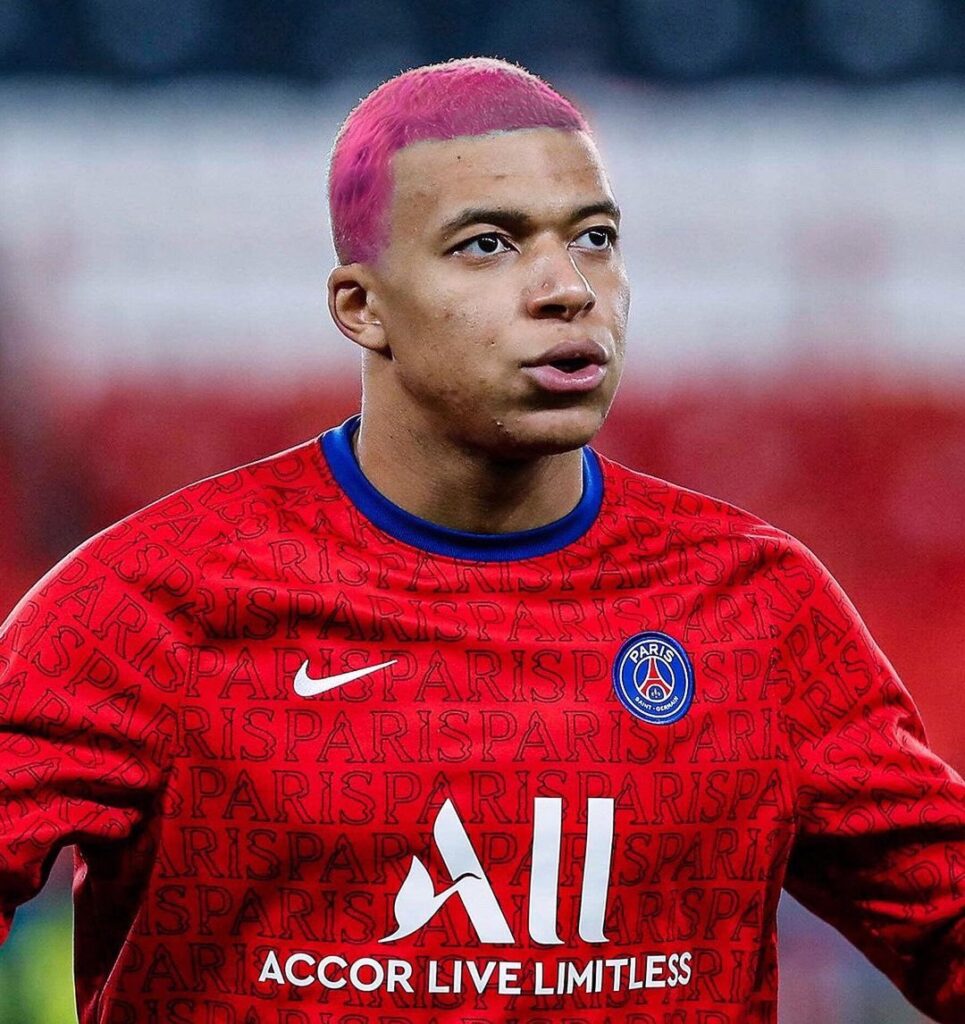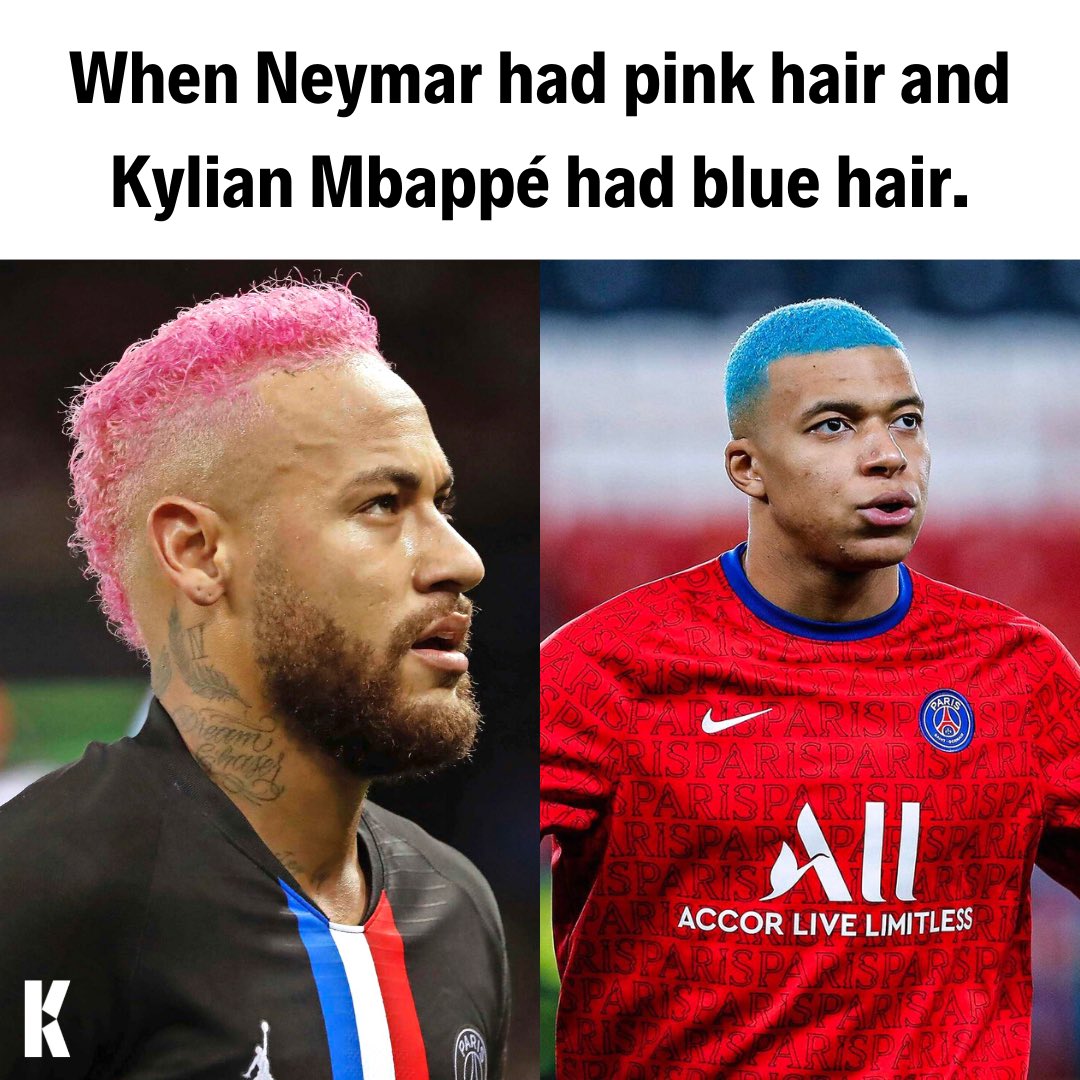Fact Check: Mbapp Pink Hair Myth - The Mandela Effect Explained!
Could it be true that Kylian Mbapp, the electrifying force of football, once sported a shock of vibrant pink hair? Unequivocally, no. This persistent, yet unfounded, belief underscores the intriguing interplay of memory, media's potent influence, and the captivating art of suggestion.
What seems like a mere triviality has unexpectedly ignited widespread fascination. Discussions are rampant across social media and within football circles, globally. This imagined image the French phenom adorned with a striking pink hairstyle has morphed into a cultural curiosity. Its a testament to the Mandela Effect in action, revealing the inherent malleability of human memory. This situation vividly demonstrates how easily collective perceptions can be molded, even when faced with readily accessible evidence that contradicts the notion. The rise of social media, with its rapid-fire dissemination of viral content and potential for visual manipulation, has significantly amplified this collective misremembering. A simple, never-existent haircut has been transformed into a pervasive, enduring misconception. Yet, this narrative transcends a simple misunderstanding. It unveils deeper insights into the confluence of culture, psychology, and social media, converging to create shared realities, even when those realities are demonstrably false.
| Category | Details |
|---|---|
| Full Name | Kylian Mbapp Lottin |
| Date of Birth | December 20, 1998 |
| Place of Birth | Bondy, France |
| Height | 1.78 m (5 ft 10 in) |
| Playing Position | Forward |
| Current Club | Paris Saint-Germain |
| International Team | France |
| Notable Achievements | FIFA World Cup Winner (2018), Ligue 1 Champion (multiple), UEFA Nations League Winner (2021), numerous individual awards |
| Professional Debut | AS Monaco (2015) |
| Style of Play | Known for exceptional speed, dribbling skills, finishing ability, and versatility. |
| Link for reference | Transfermarkt |
The origin of this Mbapp pink hair phenomenon can be traced back to a convergence of factors. It starts with Mbapp's own image; he is, after all, a personality known for his flair, both on and off the pitch. He's never been afraid to experiment with his look, including brief forays into blonde and blue hues. Back in 2017, prior to his high-profile transfer to Paris Saint-Germain, he sported a blonde hairstyle. This may have been the initial spark that ignited the confusion, creating a visual association that later morphed into the false memory of a pink tinge. Beyond this, the undeniable influence of social media platforms, especially those heavily reliant on visual content such as TikTok and Instagram, cannot be overstated. Fan art, manipulated images, and clever edits were rapidly and widely disseminated, further solidifying this illusion in the minds of countless individuals. These images, shared and re-shared ad infinitum, gained a veneer of credibility, becoming de facto "proof" of an event that never transpired.
- Netzero Message Center Login Your Ultimate Guide To Accessing Your Email
- Why X Hamsters Are The Ultimate Pet For Modern Families
The "Mandela Effect," a fascinating psychological phenomenon where a considerable number of people share the same false memory, provides further insight into the matter. The term itself originated from the widespread, yet inaccurate, recollection of Nelson Mandela's death in prison during the 1980s. In Mbapp's case, this effect likely emerged from a combination of suggestive visuals, memory distortions, and perhaps even a collective desire to see the star with a more flamboyant aesthetic. The sheer scope of this phenomenon underscores the susceptibility of the human brain to suggestion and reveals the potential for even the most firmly held memories to be skewed.
Cultural trends and influences also play a significant role in shaping our collective memory. Mbapp's public image is intrinsically linked to concepts of boldness, style, and undeniable dynamism. His hairstyles, frequently a topic of public discussion, reflect his evolving personality and the transformation of his public persona. From a close-cropped buzz cut to experiments with blonde and blue, his willingness to embrace new styles aligns seamlessly with the perception of him as a daring and fashionable figure. This, in turn, makes it easier to accept the idea of an "unconventional" hair color, even if it never actually existed.
The deluge of TikTok videos featuring hashtags such as #mbappe and #pinkhair vividly illustrates how deeply this false memory has penetrated the digital landscape. These videos, often featuring cleverly edited images of Mbapp with pink hair, serve as a clear manifestation of collective misremembering. Crucially, these edits are then often interpreted as genuine evidence, irrespective of the underlying truth. Similarly, numerous posts across platforms like Pinterest showcasing the purported pink hair further contributed to the widespread propagation of this illusion. The ease with which this type of visual content can be generated and disseminated has played a pivotal role in the sustained persistence of this memory.
The stark contrast between Mbapp's actual hair colors throughout his career and the widely imagined pink hue serves as a powerful example of how misinformation can take root and be embraced as undisputed fact. During the 2020 season, Mbapp did, in fact, experiment with blue hair dye, which is arguably closer to the imagined pink than his natural hair color. This discrepancy underscores the remarkable ease with which perception can be altered and how pre-existing biases can skew our recollections. The blue dye was a temporary style choice, a fleeting moment of self-expression. This contrasts sharply with the persistent belief in pink hair, a stylistic path he never actually pursued. It vividly illustrates the power of visual cues and the influence of pre-conceived notions in shaping our memories.
This instance gains another layer of complexity as it showcases how fan culture actively shapes public narratives. The interaction between fans, and their inherent desire to forge a deeper connection with a celebrated star, can lead to the spontaneous creation and widespread adoption of ideas, even those lacking a foundation in reality. This dynamic vividly highlights the remarkable ability of the collective imagination to contribute to the construction of narratives, thereby influencing popular perceptions and shaping the collective understanding of events. It can be interpreted as a microcosm of how fan communities contribute to the larger, often complex, narratives surrounding famous figures, simultaneously reinforcing the bonds within the fanbase.
Considering other instances of players experimenting with radical hair colors provides crucial context. For instance, Neymar, Mbapp's teammate at Paris Saint-Germain, indeed opted for a pink hairstyle earlier in the year. This real event might have inadvertently fueled the pre-existing misconception of a pink-haired Mbapp, creating a confusion of memories. It underscores how shared environments and close associations within the world of professional football can lead to memory distortions, making it easy to conflate the aesthetic choices of different players.
The question of Mbapp's hair color also offers a valuable lens through which to explore the profound impact of modern media. The relentless presentation of images, sourced from a wide range of media outlets, has the power to generate entirely new information, regardless of its veracity. In this case, the continuous circulation of edited images and fabricated stories effectively reinforces the idea of Mbapp with pink hair, even though that image is entirely fabricated. It serves as a stark reminder of the pervasive influence of digital media in shaping modern memory and highlighting how a potent combination of readily accessible visual tools and the widespread adoption of social media platforms has inadvertently allowed this false narrative to not only flourish but also gain widespread acceptance.
This particular instance also connects to broader discussions surrounding the nature of memory itself. It underscores the fact that the human brain is not a flawless recording device, but rather a sophisticated interpreter. Our memories are not simply replayed, but rather actively constructed and inherently susceptible to external influences. As this case so aptly demonstrates, our memories are constantly being re-evaluated, refined, and reshaped over time. Furthermore, the role of emotions and context cannot be overlooked in the memory creation process. The emotional connections that fans cultivate with athletes, and the specific context surrounding those interactions, inevitably impact the way those memories are formed, stored, and recalled.
This case study involving Mbapp's hair serves as a powerful reminder of the ease with which digital misinformation can spread rapidly and become integrated into our collective memory. This phenomenon offers a valuable lens through which to understand the intricate dynamic between social media, individual perception, and broader cultural trends. It stands as a testament to the immense influence of visual media in shaping our understanding of the world and highlights the inherent malleability of human memory. While there may not be a definitive solution to completely prevent such instances, gaining a deeper understanding of these underlying mechanisms can empower us to become more discerning consumers of information and more critical evaluators of the content we encounter.
The widespread acceptance of this false memory vividly demonstrates the significant role that the Mandela Effect can play in shaping popular culture. It reveals that the phenomenon is not simply about misremembering isolated details, but also about the active formation of shared realities that can transcend individual experiences. Although the case of Mbapp's hair color is relatively innocuous in its implications, it offers valuable insight into how this phenomenon can potentially affect our perception of information in general and how we interpret the events unfolding around us. By gaining a clearer understanding of these aspects, we are better equipped to critically assess the validity of the information we receive, question the narratives that are presented to us, and ultimately, form our own informed opinions.
The fact that the the keyword term Mandela Effect is the noun is crucial for this article, the noun "Mandela Effect" represents a key concept, and focusing on its definition, characteristics, and impact helps reinforce the article's main argument about memory and perception.
- Saxon Musk The Untold Story Of A Rising Star In The Tech World
- Matt L Jones The Rising Star Taking The Music World By Storm

Mbappe's Pink Hair A Colorful Misunderstanding

Mbappe's haircuts Best hairstyles to inspire your next trim Soka54

Mbappé Pink Hair The Trendsetting Style Of The Football Superstar